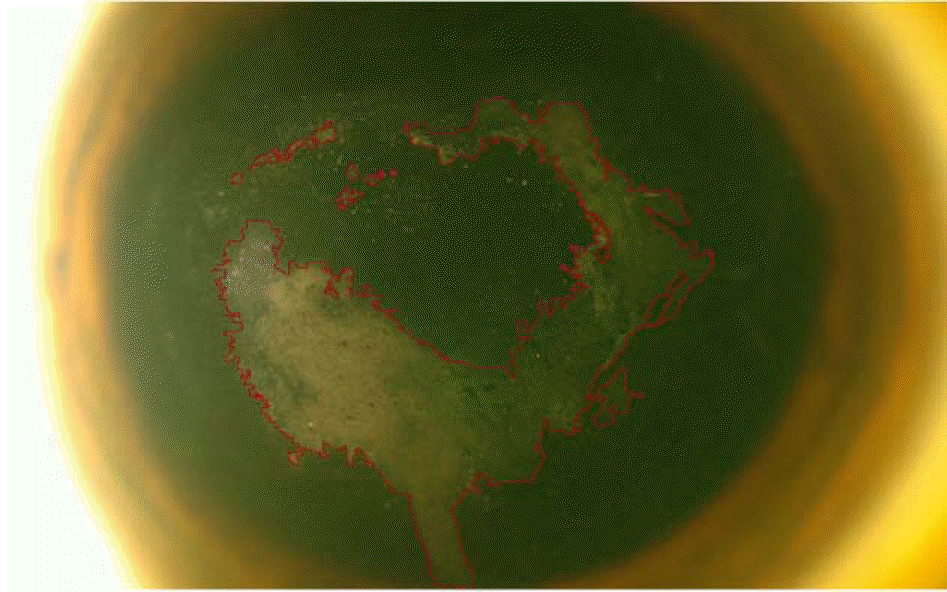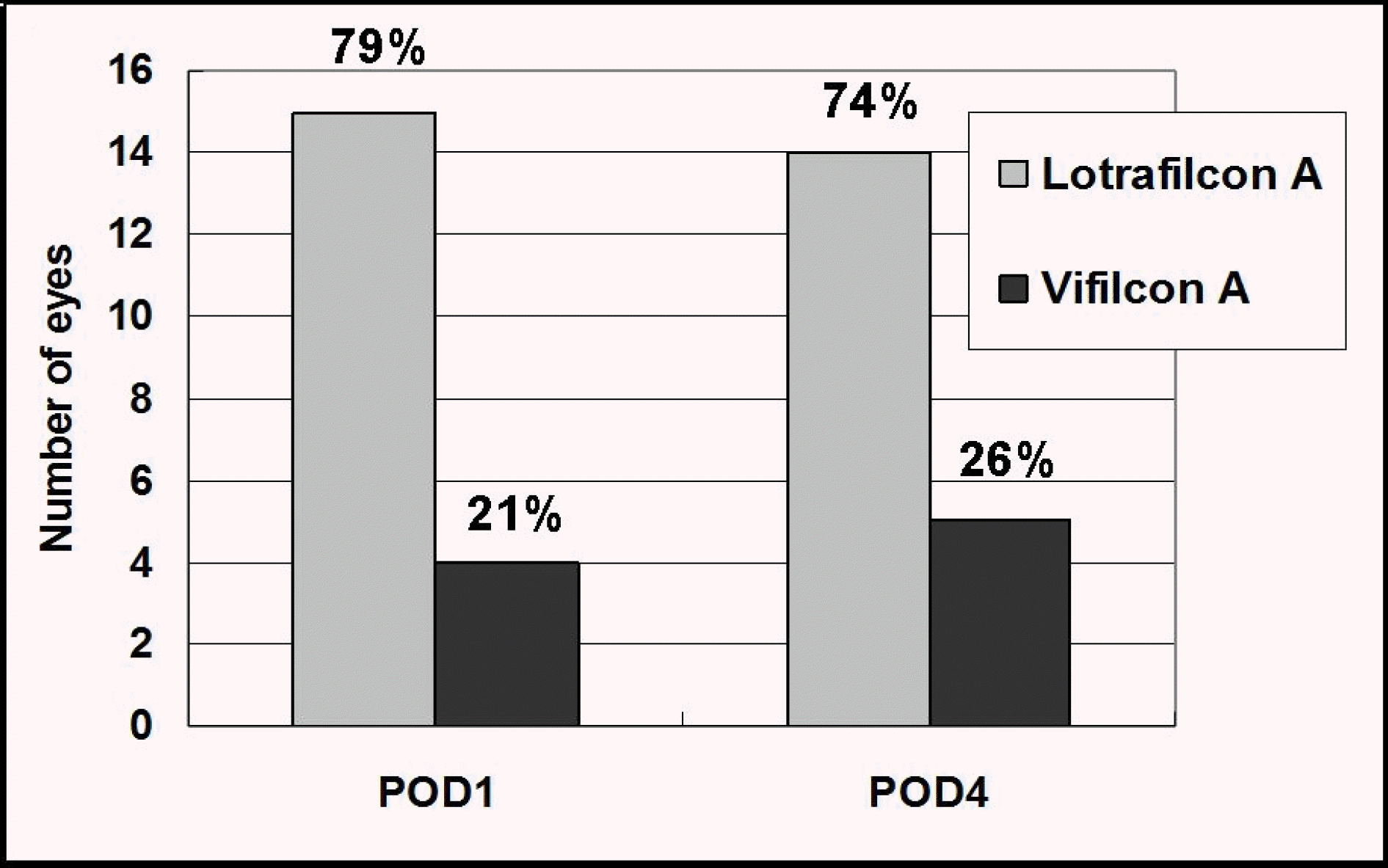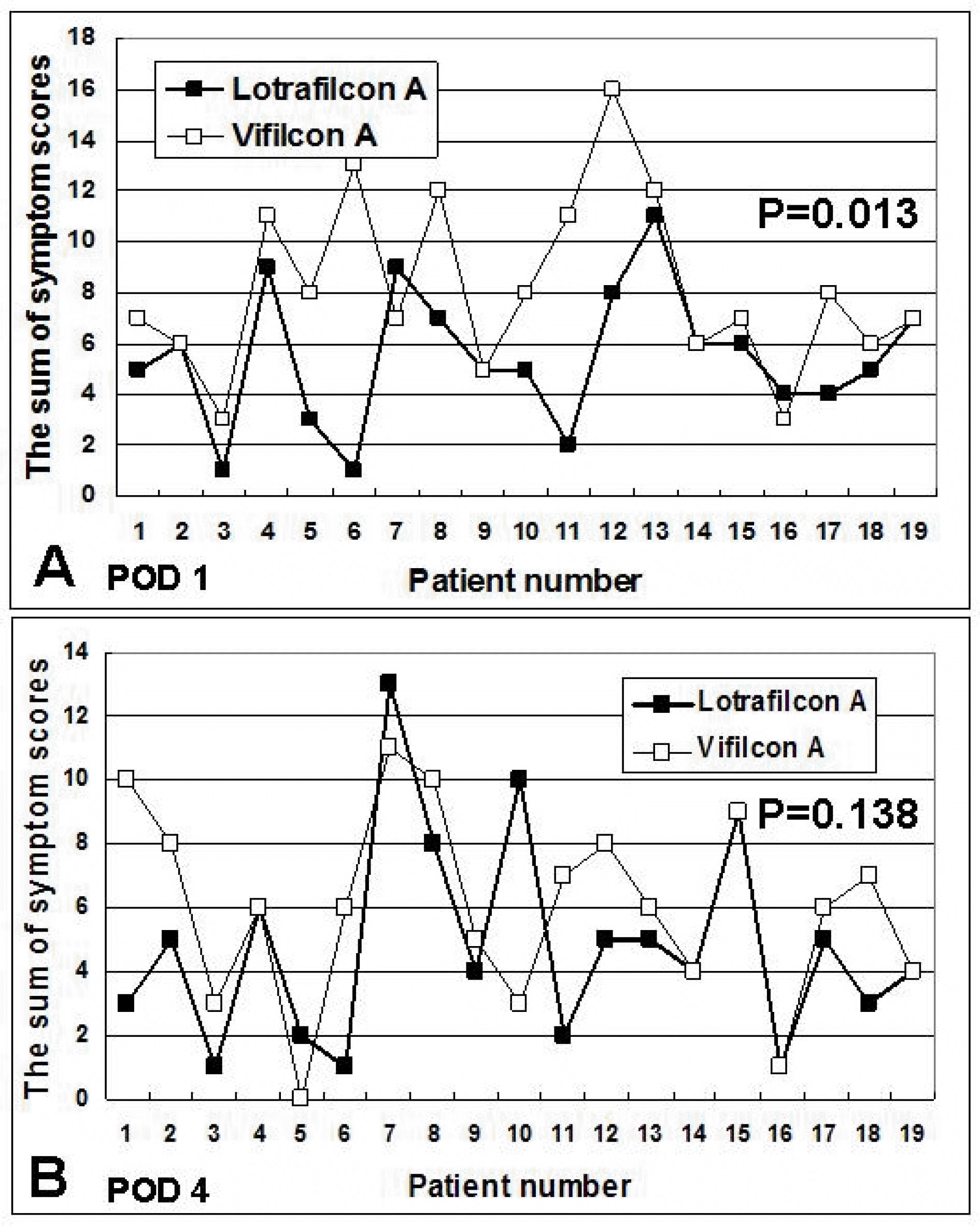Abstract
Purpose
To compare the effectiveness between wearing a conventional hydrogel vifilcon A bandage contact lens (BCL) and a silicone hydrogel lotrafilcon A BCL after laser-assisted subepithelial keratomileusis (LASEK).
Methods
LASEK was performed on 38 eyes of 19 patients. Each patient was fitted with a silicone hydrogel lotrafilcon A lens in one eye and a conventional hydrogel vifilcon A lens in the other eye. The patient was masked on the type of lens in each eye. General preference between the two types of lenses, subjective symptoms (pain, photophobia, tearing, dryness, and foreign body sensation; graded as 0 to 4), and the area of non-viable corneal epithelium were assessed in each eye at one and four days after surgery.
Results
Patients reported preferring the lotrafilcon A lens to vifilcon A at 1 (79%) and 4 (74%) days after LASEK. The mean symptom scores of tearing and foreign body sensation at 1 day after surgery (P=0.012 and P=0.034, respectively) and foreign body sensation at 4 days after surgery (P=0.027) were significantly lower in the lotrafilcon A group. The mean area of the non-viable corneal epithelium was smaller in the lotrafilcon A lens group at 1 day and 4 days after surgery, although not statistically significant.
Go to : 
References
1. Dastjerdi MH, Soong MK. LASEK (laser subepithelial keratomileusis). Curr Opin Ophthalmol. 2002; 13:261–3.

2. Anderson NJ, Beran RF, Sohneider TL. Epi-LASEK for the correction of myopia and myopic astigmatism. J. Cataract Refract Surg. 2002; 28:1343–7.

3. Litwak S, Zadok D, Garcia-de Quevedo V, et al. Laser-assisted subepithelial keratectomy versus photorefractive keratectomy for the correction of myopia. A prospective comparative study. J Cataract Refract Surg. 2002; 28:1330–3.
4. Bergenske P, Caroline P, Smithe J. Contact lenses as an adjunct in refractive surgery practice. CL Spectrum. 2002; 17:30–7.
5. Duane TD. Therapeutic hydrogel lenses. In : Duane TD, editor. Clinical Ophthalmology. New York: Harper & Row;1978. v. 4. chap. 10.
6. Gould HL. Therapeutic experiences with soft contact lenses. Trans Am Acad Ophthalmol Otolaryngol. 1974; 78:391.
7. Duke-Elder S. System of Ophthalmology. 5. Philadelphia: C.V. Mosby;1970. p. 786.
8. Sampson WG. Symposium; Soft contact lenses. Trans Am Acad Ophthalmol Otolaryngol. 1974; 78:383.
9. Szaflik JP, Ambroziak AM, Szaflik J. Therapeutic use of a lotrafilcon A silicone hydrogel soft contact lens as a bandage after LASEK surgery. Eye Contact Lens. 2004; 30:59–62.

10. Lim L, Tan DT, Chan WK. Therapeutic use of Bausch & Lomb PureVision contact lenses. CLAO J. 2001; 27:179–85.
11. Engle AT, Laurent JM, Schallhorn SC, et al. Masked comparison of silicone hydrogel lotrafilcon A and etafilcon A extended-wear bandage contact lenses after photorefractive keratectomy. J Cataract Refract Surg. 2005; 31:681–6.

12. Lee JH, Do SJ. Therapeutic uses of T-lens (Soflens) in corneal diseases. J Korean Ophthalmol Soc. 1983; 24:269–72.
13. Leibowitz HM. Hydrophilic contact lenses in corneal disease, IV. Penetrating corneal wounds. Arch Ophthalmol. 1972; 88:602.
14. Dohlman C, Boruchoff S, Mobilia E. Complications in use of soft contact lenses in corneal disease. Arch Ophthalmol. 1973; 90:367–71.

15. Tighe B. Silicone hydrogels-what are they and how should they be used in everyday practice? Optician. 1999; 218:31–2.
16. Montero J, Sparholt J, Mely R. Retrospective case series of therapeutic applications of a lotrafilcon A silicone hydrogel soft contact lens. Eye Contact Lens. 2003; 29:S54–6.

17. Dumbleton K, Chalmers R, Richter D. Vascular response to extended wear of hydrogel lenses with high and low oxygen permeability. Optom Vis Sci. 2001; 78:147–51.

18. Ren D, Yamamoto K, Ladage PM, et al. Adaptive effects of 30-night wear of hyper-02 transmissible contact lenses on bacterial binding and corneal epithelium. Ophthalmology. 2002; 109:127–39.
Go to : 
 | Figure 1.Slit-lamp biomicroscopic image of a patient after LASEK. Non-viable corneal epithelium is shown as gray zone within the red outline. |
 | Figure 2.General preference between two types of lenses- lotrafilcon A lens vs. vifilcon A lens - at 1 and 4 days after LASEK surgery. (POD-postoperative day). |
 | Figure 3.The sum of symptom scores in each eye of the lotrafilcon A lens and vifilcon A lens groups (19 eyes in both groups) at 1 (A) and 4 (B) days after LASEK surgery. Solid and dashed horizontal lines indicate the mean values in the lotrafilcon A lens and vifilcon A lens groups, respectively. Mean total symptom score was significantly smaller in the lotrafilcon A lens group at 1 day postoperatively (P=0.013, by Wilcoxon's rank sum test), and did not show statistically significant difference between the two groups at 4 days postoperatively (P=0.138, by Wilcoxon's rank sum test). (POD; postoperative day). (POD-postoperative day). |
Table 1.
Mean scores of subjective symptom in patients after LASEK surgery
Table 2.
The number of eyes which belonged to each classification
| Symptoms |
Lotrafilcon A |
Vifilcon A |
P-values | ||
|---|---|---|---|---|---|
| Good | Poor | Good | Poor | ||
| Pain | 14 | 5 | 8 | 11 | 0.049 |
| Photophobia | 13 | 6 | 11 | 8 | 0.501 |
| Tearing | 15 | 4 | 8 | 11 | 0.020 |
| Dryness | 14 | 5 | 11 | 8 | 0.305 |
| Foreign body sensation | 13 | 6 | 6 | 13 | 0.023 |
Table 3.
Mean±standard deviation area of non-viable corneal epithelium (cm2), which were outlined in anterior segment photographs and calculated with EssenView System (Essensoft, Seoul, Korea), at 1 and 4 days after LASEK surgery in the lotrafilcon A lens and vifilcon A lens groups (19 eyes in both groups)
| Lotrafilcon A | Vifilcon A | P-values | |
|---|---|---|---|
| POD1 | 0.516±0.143 | 0.539±0.134 | 0.558 |
| POD4 | 0.072±0.076 | 0.072±0.091 | 0.769 |




 PDF
PDF ePub
ePub Citation
Citation Print
Print


 XML Download
XML Download